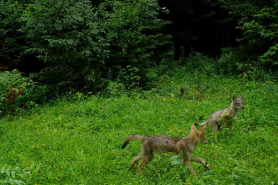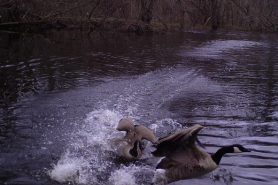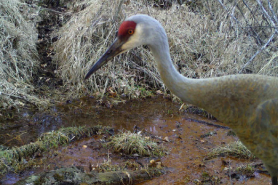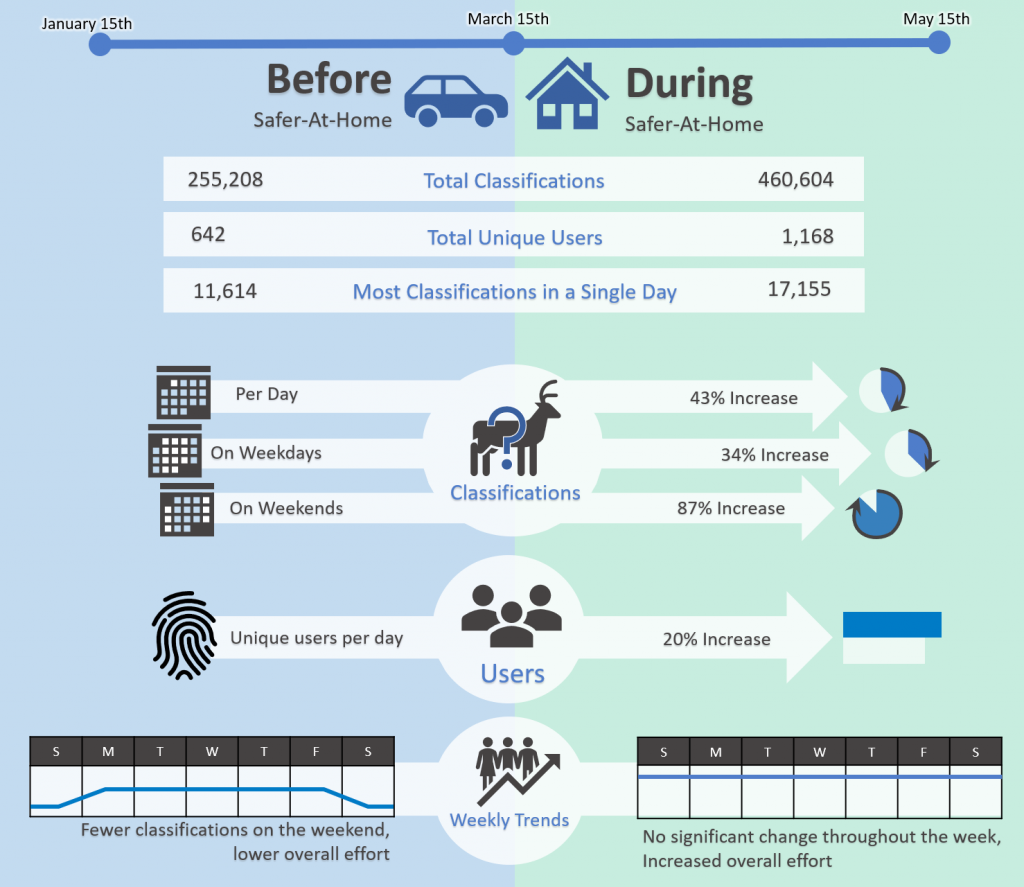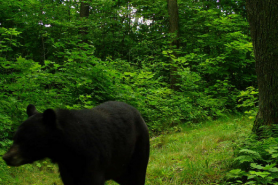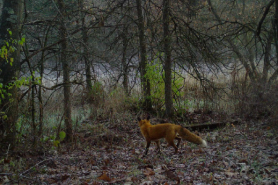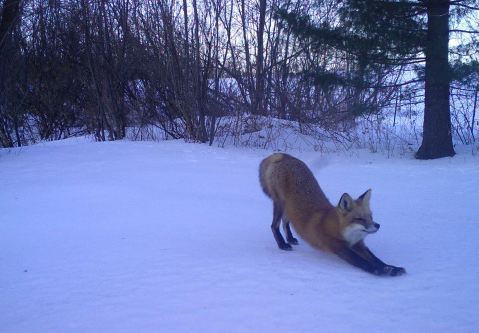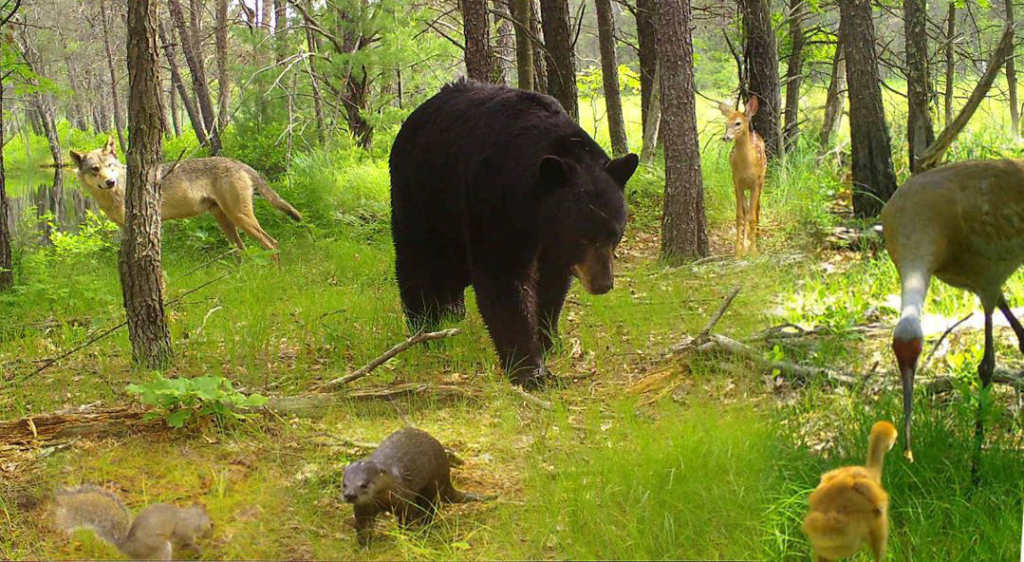The Snapshot July 2020
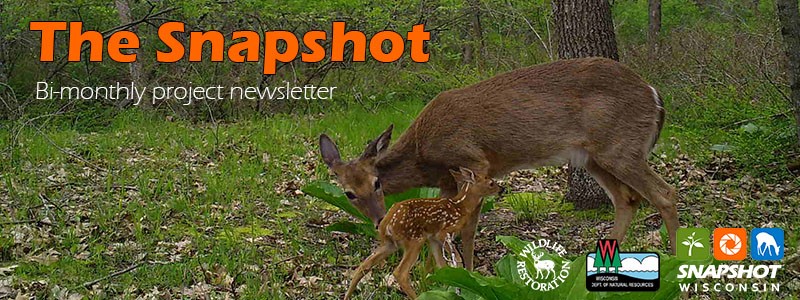
Amidst the Pandemic, Citizens Create a Boost in Classifications
The Snapshot team talks about how the pandemic has impacted them, and one member of the team analyzes the increase in daily classifications since mid-March.
Contributing to Science While At-Home
The Safer at Home order and ongoing risks during the COVID-19 pandemic mean more time at home for many Wisconsinites. The Snapshot team highlights ways to stay entertained while still contributing to science, including the Snapshot Wisconsin Bird Edition and the Snapshot discussion board on Zooniverse. The team also unveils Snapshot Yoga and Snapshot Bingo: two new, interactive options that are perfect for rainy summer days.
Announcements
Follow Snapshot Wisconsin on Zooniverse.com to learn more about the program, as well as related topics like native plants that impact wildlife. Plus, we celebrate a volunteer who has been with the program for over five years!
Amidst the Pandemic, Citizens Create a Boost in Classifications
We would like to thank everyone who has helped classify Snapshot photos during the pandemic. We are happy to see so many of our volunteers connecting with nature while at home.
We want to share how the pandemic has affected the Snapshot Wisconsin team and offer a look at the surge in classifications. Jennifer Stenglein, Research Scientist at the Wisconsin DNR, shares some encouraging findings about the rise in daily classifications and Zooniverse classifiers during the pandemic.
The Snapshot Team During the Pandemic
“I think Snapshot has been a success story,” said Stenglein. “The effects of COVID-19 haven’t been very detrimental to the team. Change happened, and we adjusted. Some of our workload shifted, but we continued to be Snapshot - just in a slightly different way.”
The Snapshot team is very collaborative. Each week, team members must heavily coordinate with each other to keep photos moving to the next steps and interacting with a volunteer base of over 2,000 people. However, since Wisconsin’s Safer at Home order went into effect in late March, the Snapshot team has been teleworking from home. Stenglein said, “To me, that’s been the biggest change: not having face-time with the team. But the team has transitioned really well to having online meetings.”
There is now a bigger focus on getting photos to Zooniverse for our volunteers to classify. With more people at home, Snapshot photos are being classified at a faster rate than before. This increase in daily classifications is what first alerted the team to the boost.
Investigating the Surge
Stenglein has been a member of the Snapshot team since its beginning in 2013. She leads the scientific program at Snapshot and plays a vital role in turning quantitative data into usable metrics (for example, calculating county fawn-to-doe ratios). Stenglein was the first to offer to investigate the boost in detail, as she was excited to learn more about our volunteers and their behavior.
The first step to investigating this boost was to determine what time frames should be compared. Two time frames were needed: One from before the pandemic and one during the pandemic. “Our Zooniverse volunteers come from all over the world, and the pandemic has affected different places differently. But a lot of our Zooniverse traffic comes from Wisconsin, so we thought selecting a timeframe that was relevant to Wisconsin was a good approach.” Additionally, because Snapshot Wisconsin is a Wisconsin DNR program, a Wisconsin-centric time frame seemed natural.
To narrow down the time frames even more, the team needed to choose a specific date as the delineator between the two time frames. “March 15th correlates to about the time when the Department of Health Services started collecting their stats. It was less than two weeks later that the Safer at Home order went into effect. We felt like this date was a good mix of a time frame important to Wisconsin and a line in the sand. We needed that [break] point between pre-pandemic and mid-pandemic.” At least two months of data was needed to ensure reliability, so the two months prior (pre-pandemic: Jan. 15–March 14, 2020) and the two months after (mid-pandemic: March 15-May 15, 2020) were chosen.
With the time frames set, Stenglein began compiling the data for the analysis. However, before we get to Stenglein’s analysis, it helps to understand the difference between a photo, a trigger and a classification. Those who have classified Snapshot photos before will recall that you were given three photos at a time to classify as a set. Volunteers are asked to classify the set as one whole, meaning they would tag the set as having a red fox if a red fox was present in at least one of the three photos. Each set of photos is called a trigger and gets classified by multiple volunteers before it is retired on Zooniverse to ensure accuracy. Each time a trigger is classified by a volunteer, that is called a classification. Simply said, three photos make a trigger, and a classification is each time a volunteer looks at that trigger before the trigger retires.
The Boost: Analyzed
In total, our volunteers made 460,604 classifications during the pandemic - a huge increase from the 255,208 classifications prior to the pandemic. While each classification doesn’t perfectly translate to the number of triggers retired, this boost is a huge increase in Snapshot’s turnover rate for triggers. Additionally, a total of 1,168 unique classifiers logged in during the pandemic, almost double the number from pre-pandemic.
Classifiers were also, on average, classifying 11.6% more triggers each time they logged on. Once we saw that people were classifying for longer, we wondered what other behavioral shifts have occurred since the pandemic started. One big shift is seen in our established classifiers, or volunteers who were already active on Zooniverse before the pandemic. Stenglein saw that established classifiers were logging in and classifying on significantly more days than before, and they were classifying more triggers each time. However, Stenglein noticed that there were fewer sessions per day. A session is similar to a sitting in that one volunteer could classify triggers over multiple sittings in a single day. Altogether, our established classifiers were classifying more triggers, on more days, but fewer times per day than pre-pandemic.
The most classifications in a single day occured on March 29, less than a week after the Safer at Home order went into effect in Wisconsin. A total of 17,155 triggers were classified on that single day.
On intuition, Stenglein had an idea to check if there was a difference among the days of the week. Do volunteers classify differently on the weekends than on weekdays? “The weekend/weekday idea was something that I thought of because it was coming up on the weekend. I was thinking, ‘Man, these days all feel the same.’ I got intrigued by this question and wanted to know,” said Stenglein. “But I didn’t even know what the baseline was.”
Stenglein continued, “I was very interested to find out that [normally, pre-pandemic] weekends have much fewer classifications compared to weekdays. I could have hypothesized the opposite and convinced myself.” In fact, the total number of triggers classified rose for both weekends and weekdays, although unequally. We saw an increase of 34% during weekdays (1,507 more triggers classified each weekday) and 86.7% during weekends (2,452 more triggers classified each day of the weekend).
“I was really fascinated that both weekdays and weekend classifications went up [during the pandemic], but when you compare them now, there no longer is a distinction between them. I think that was my favorite finding,” said Stenglein. “With fewer options of things to do on the weekend, perhaps [volunteers] are willing to sit down and spend more time on Zooniverse.”
Stenglein also compared the mid-pandemic period (March 15–May 15, 2020) to a similar time frame from the year prior (March 15–May 15, 2019). Stenglein said, “It helped me to really believe in this boost idea when I looked at the same time period from the previous year and found almost identical results. There is really something unique about this [mid-pandemic] time period.”
Continued Support
Stenglein said, “There is value in communicating this data back to volunteers who are working extra hard right now by classifying photos. You are increasing our capacity to turn over photos and helping us get through our backlog.” In fact, classifiers helped process over 10% of Snapshot’s backlog since the pandemic started.
The Snapshot staff were excited to see this rise in classifications because a quicker turnaround time for photos means more up-to-date data for wildlife management decisions. Continuing to reduce the backlog of photos is an important way that the public (and Snapshot volunteers specifically) can contribute to the project and wildlife monitoring.
“Back in January, we had a meeting about how to deal with unclassified photos. We came up with all these great new ideas, but a pandemic was not among them. The pandemic is never good news, but it provided an opportunity to get through so many unclassified photos in a way that wouldn’t have been possible,” said Stenglein.
But in order to provide key measures to decision makers about animal distribution and abundance, Snapshot needs continued support from the public to keep classifying photos and monitoring wildlife in Wisconsin. Stenglein said, “Snapshot is a volunteer program. There is no Snapshot without its volunteers, and they are what makes Snapshot successful. Citizen science [projects] are a wonderful thing to participate in, and it’s a way to work with others towards research, science and wildlife decision support. People care about helping monitor wildlife and helping the DNR understand the wildlife in their own backyards.”
Stenglein and the Snapshot team want to thank the thousands of volunteers who have helped classify photos during the pandemic. “We are super grateful for the increased traffic and time that people have been putting into Zooniverse.”
Stenglein added, “On a personal note, I’ve been classifying photos with my son, which has been really fun. I’m glad that Snapshot provides an opportunity to see wildlife [while we are stuck indoors].” The Snapshot team encourages classifying photos together with loved ones. Check out the next article in this newsletter to see more ways to stay connected with nature!
Contributing to Science While At Home
While the world is practicing social distancing, it can feel like there are limited options to stay connected with friends and family. Inspired by the boost in classifications during the pandemic, the Snapshot team wants to highlight ways that people can have fun together and still contribute to science.
Emily Buege Donovan, Research Scientist at the Wisconsin DNR and member of the Snapshot Wisconsin team, discusses a new opportunity within Snapshot Wisconsin and other ways to make classifying photos a group activity.
Donovan holds two positions within Snapshot, a database manager and spatial analyst. “I do a lot of spatial analysis, mapping and managing our spatial datasets,” said Donovan. “I also manage a lot of the Zooniverse data and regular functions of the Zooniverse site, and I support science products within Snapshot. It is a lot of odds and ends.” But of late, Donovan has been focusing on a new classification project within Snapshot.
Snapshot Wisconsin Bird Edition: Explained
“Snapshot Wisconsin Bird Edition, as we’re calling it, is a collaboration between Snapshot Wisconsin and the Natural Heritage Conservation, specifically the Wisconsin Breeding Bird Atlas II,” said Donovan. The Wisconsin Breeding Bird Atlas II is a multi-year census of the birds that are breeding in Wisconsin. Through documenting current bird breeding patterns and distribution, we can compare them to future numbers and identify areas that could be improved for better bird conservation efforts in Wisconsin.
Donovan explained, “At Snapshot, we classify only a handful of birds to the species-level, especially those of special management interest.” Whooping cranes, sandhill cranes and a few upland birds like turkey, grouse and pheasant are the only birds that are classified to the species level. “Everything else, all the other 250-plus species of birds that are found in Wisconsin, get classified as ‘Other bird.’ We have a long history of bird photos that were categorized into the umbrella category of ‘Other bird,’ and the Wisconsin Breeding Bird Atlas II was interested in any examples we had of birds breeding.”
Using catalogued photos that were previously classified as ‘Other bird,’ volunteers can add observations to the Wisconsin Breeding Bird Atlas II through Zooniverse, just like when they are classifying for Snapshot. “The first step,” said Donovan, “is to classify these photos to the species level. The second step is to determine whether there is any evidence of breeding. Examples are birds carrying nesting materials, a pair of birds in suitable habitat or young birds like fledglings.”
Anyone with a bird field guide or the internet can contribute to this new project. There are resources available on the Zooniverse page that describe how the breeding codes work for birds. Donovan encourages anyone with an interest in birds and birding to participate.
“This is actually a really good way to practice birding,” said Donovan. “You can rewatch the sequence as many times as needed to get a good look. The bird isn’t going to fly away. Plus, you can dedicate as much or as little time as you want.”
Join the Community on the Zooniverse Discussion Board!
In addition to the Snapshot Wisconsin Bird Edition, the Snapshot team also encouraged people to give the Snapshot discussion board a try. The discussion board can be found on the Snapshot Zooniverse page under the “Talk” tab.
“You can use it to help identify a tricky photo or ask for a second opinion. It’s also a great way to interact with the researchers and find out more about the project,” said Donovan. The discussion board has a community of frequent classifiers from across the globe who interact with each other using this feature. “With the current events going on, you can’t always get out and interact with people in person, so [the discussion board] is a great way to meet fellow wildlife enthusiasts and interact.”
Zooniverse allows classifiers to share individual photos to the discussion board. Whether sharing a silly animal selfie, an interesting coat pattern, or asking a question about an animal’s behavior, volunteers can share cool photos for others to see. Additionally, photos can be saved into collections. Collections, viewable under the “Collect” tab, are a great way to save your favorite pictures and are an easy way to see what others have saved.
It is also common to tag photos with popular hashtags, such as #Multi_Species and #Interesting_Behavior, which automatically get added to each hashtag’s collection. Others can click on or search for that hashtag to find all of the photos with that specific tag. These hashtag and collection features are available without sharing them to the discussion board, but isn’t it more fun to share cool photos with others who will appreciate them?
One important hashtag of note is #SuperSnap. The #SuperSnap photos are reviewed each month by the Snapshot team, and one is chosen to be featured on our Zooniverse page. If you have a moment today, check out the great photos under the #SuperSnap collection! Or tag the best photos you come across, because one might get featured in a future post.
New Snapshot Activities
The Snapshot team has also been working on a few new ways that people can use Snapshot to stay involved with people they care about. Whether you are a parent looking for an afternoon activity to keep your kids entertained or friends wanting to do something meaningful together online, Snapshot has a few new options you can consider.
Snapshot already has lesson plans for educators on its website, but sometimes you don’t get the luxury of time to plan activities. “Having a niece and nephew myself, I understand you don’t always have the ability to plan ahead,” said Donovan. So, Snapshot developed two quick activities that you can do to spend time with someone you care about and help contribute to wildlife monitoring in Wisconsin.
The first activity is a Snapshot version of Bingo [PDF]. All the planning one needs to do is print out the bingo board and fill the spaces in using our recommendations or ones you come up with yourself. Then, jump on your Zooniverse account and classify photos until you come across a photo that fits a Bingo space and mark that space off. Play can be cooperative, playing with someone you can’t physically meet up with because of health concerns or distance, or play can be competitive between siblings or friends. The game is what you make it, so make it your own version of fun!
The second new activity is Snapshot Yoga [PDF]. In Snapshot Yoga, volunteers spend ten or so minutes classifying photos on Zooniverse, saving their favorites into a special collection. Then, as an away-from-screen activity, volunteers can try mimicking the photos in their collection. Any brave souls are welcome to share with us a photo of themselves trying one of these poses. Bonus points if you can capture a special Snapshot yoga moment with a friend, family member or pet! Donovan added, “I like that you can do these activities competitively or cooperatively. You can even send the photos to each other that you find [while classifying] to share them back and forth.”
“I think these activities are entertaining for people of all ages, not just kids. Especially Wisconsinites, we have an interest and pride in our wildlife. People love looking at photos of animals. But this is different from a lot of other activities because it is interactive and contributes to wildlife research,” said Donovan. Descriptions of both activities can be found on the Snapshot webpage along side our resources for educators.
The next rainy day, the next time you’re craving some cool photos of animals, or the next time you want to do a fun activity with a loved one, consider Snapshot Wisconsin as an option. Just because we are practicing social distancing doesn’t mean we can’t still interact with those we care about and contribute towards something bigger than ourselves.
Announcements
At the end of each newsletter, we typically feature a photo of the month, but this month we decided to do something a bit different. We want to highlight a big milestone of one of our volunteers. A special thanks to Steve from Clark County for being with the Snapshot Wisconsin program for five whole years. He deployed his first cameras in the Black River Falls elk reintroduction area in May of 2015. Today, Steve is a moderator on our Snapshot Wisconsin Zooniverse site, helping other volunteers across the world learn about Wisconsin wildlife. This photo collage of animals he’s helped classify over the years was created by the Snapshot Wisconsin team as a small token of our appreciation. Thank you, Steve!
Snapshot Wisconsin wouldn’t be the same without Steve and the other volunteers who help make this program possible. We appreciate all the help that you all give to Snapshot Wisconsin!




